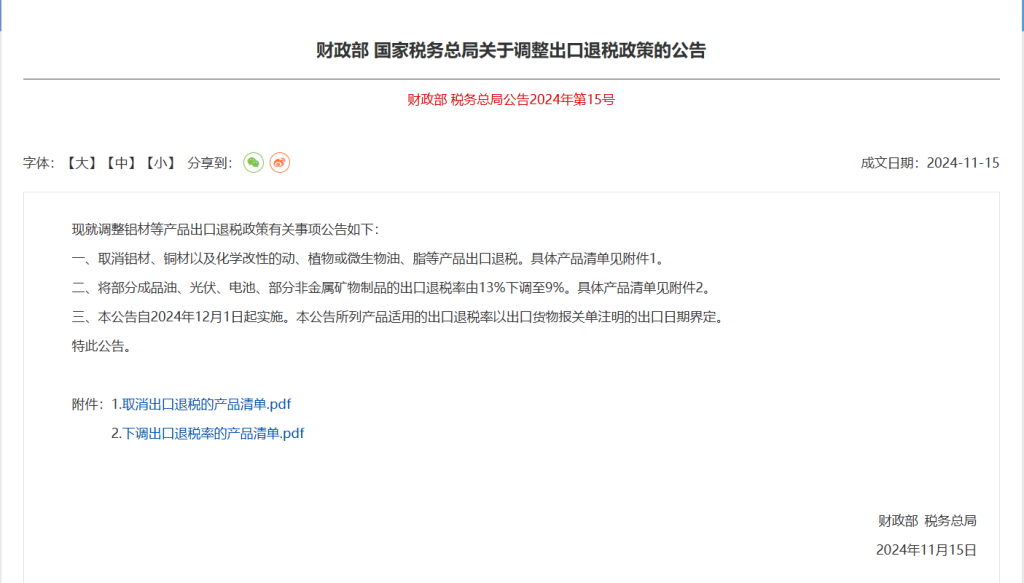Chinas Reduzierung der Exportsteuerrückerstattung für Photovoltaik und Energiespeicherung im Jahr 2024: Auswirkungen auf die Branche und Analyse der Zukunftsaussichten
Veröffentlichungszeitpunkt: 26.11.2024
Im Jahr 2024 werden Chinas Photovoltaik- und Energiespeicherung Branchen werden mit der Herausforderung einer Reduzierung der Exportsteuerrückerstattungen konfrontiert sein. Obwohl die Photovoltaikindustrie von politischen Maßnahmen betroffen ist und die Kostensteigerungen kleine und mittlere Unternehmen beeinträchtigen können, stützt die weltweite Nachfrage nach sauberer Energie weiterhin ihr Exportwachstum. Auch die Energiespeicherindustrie steht unter Druck, insbesondere bei Low-End-Produkten, aber technologische Innovationen und die Marktnachfrage werden das Wachstum von High-End-Energiespeicherprodukten ankurbeln. Unternehmen müssen Forschung und Entwicklung verstärken, die Produktionseffizienz verbessern und den Markt erweitern, um mit politischen Änderungen fertig zu werden. Insgesamt bleiben die langfristigen Aussichten der Photovoltaik- und Energiespeicherindustrie optimistisch.

Exportstatus und Trends der Photovoltaikindustrie
Als eine der weltweit führenden Fertigungsindustrien hat Chinas Photovoltaikindustrie in den letzten Jahren eine starke Wachstumsdynamik bei den Exporten aufrechterhalten. Im Jahr 2024 könnte sich das Marktumfeld der Photovoltaikindustrie mit der Anpassung der Exportsteuerrückerstattungspolitik erheblich ändern. Das Exportvolumen der Photovoltaikindustrie dürfte im Jahr 2024 weiter wachsen, aber die Reduzierung der Steuerrückerstattungen wird einige Unternehmen unter Druck setzen.
Prognose zum PV-Exportvolumen 2024:
Jüngsten Daten zufolge werden Chinas Gesamtexporte an Photovoltaikprodukten im Jahr 2024 voraussichtlich 1412 Milliarden US-Dollar erreichen. Zwar wird die Reduzierung der Steuervergünstigungen gewisse Kostensteigerungen mit sich bringen, doch das Wachstum der weltweiten Nachfrage nach sauberer Energie bietet der Photovoltaikbranche immer noch breite Marktaussichten.
Die Auswirkungen der Export- und Steuervergünstigungspolitik auf die Energiespeicherindustrie
Wie die Photovoltaikbranche steht auch die Energiespeicherbranche vor der Herausforderung reduzierter Exportsteuerrückerstattungen. Das Wachstumspotenzial des Energiespeichermarktes macht die Branche jedoch weiterhin äußerst wettbewerbsfähig. Der Export der Energiespeicherbranche wird hauptsächlich durch politische Unterstützung, technologische Innovationen und Veränderungen der internationalen Marktnachfrage beeinflusst.
Änderungen bei Steuervergünstigungen in der Energiespeicherbranche:
Im Jahr 2024 wird die Reduzierung des Exportsteuerrückerstattungssatzes für Energiespeicherprodukte wird die Gewinnmargen einiger kleiner und mittlerer Unternehmen beeinträchtigen. Große Energiespeicherunternehmen können jedoch ihren Marktanteil durch Skaleneffekte und technologische Innovationen aufrechterhalten. Chinas anhaltende Innovationen und Kostenvorteile bei der Energiespeichertechnologie werden dem Land helfen, seine Wettbewerbsfähigkeit auf dem internationalen Markt aufrechtzuerhalten.
Konkrete Auswirkungen der Steuervergünstigungspolitik auf die Photovoltaikindustrie
Herausforderungen für die Photovoltaikbranche:
Die Auswirkungen der Steuervergünstigungskürzung im Jahr 2024 auf die Photovoltaikbranche spiegeln sich vor allem in den steigenden Kosten für Produktexporte wider, insbesondere für kleine und mittlere Photovoltaikunternehmen. Branchenanalysen zufolge könnten einige Photovoltaikunternehmen aufgrund steigender Kosten einem größeren Gewinndruck ausgesetzt sein.
Reaktionsstrategie:
Um die Herausforderungen der Steuervergünstigungspolitik zu bewältigen, müssen Photovoltaikunternehmen ihre Produktionseffizienz und technologische Innovation stärken, Kosten senken und den Mehrwert ihrer Produkte steigern. Darüber hinaus ist die Marktdiversifizierung auch eine wirksame Möglichkeit für Photovoltaikunternehmen, mit politischen Veränderungen umzugehen. Durch die Erschließung neuer internationaler Märkte, insbesondere der Länder entlang der „Belt and Road“-Initiative, können Photovoltaikunternehmen das Risiko verringern, sich auf einen einzigen Markt zu verlassen.
Steueränderungen in der Energiespeicherbranche und ihre Marktreaktionsstrategien
Auswirkungen der Steueranpassung auf den Energiespeichermarkt:
Steueränderungen in der Energiespeicherbranche werden auch zu steigenden Unternehmenskosten führen, insbesondere für Hersteller von Low-End-Energiespeicherprodukten, die einem größeren Marktdruck ausgesetzt sein könnten. Gleichzeitig besteht nach wie vor eine starke Marktnachfrage nach High-End-Energiespeicherprodukten, insbesondere in den Bereichen Stromspeicherung und Aufladen von Elektrofahrzeugen.
Marktreaktionsstrategie:
Angesichts der Steueranpassungen sollten Energiespeicherunternehmen ihre Innovationskraft stärken, ihr technisches Niveau verbessern und die Kosten durch eine Erhöhung des Produktionswerts teilen. Darüber hinaus werden die Förderrichtlinien der Regierung für die neue Energiebranche noch eingeführt, und Energiespeicherunternehmen können durch eine verstärkte Zusammenarbeit mit der Regierung mehr politische Unterstützung erhalten.
Zukunftsaussichten der Photovoltaik- und Energiespeicherindustrie
Zukünftige Entwicklungstendenzen der Photovoltaikindustrie:
Obwohl die Anpassung der Steuerrückerstattungspolitik im Jahr 2024 gewisse Herausforderungen mit sich gebracht hat, sind die langfristigen Entwicklungsaussichten der Photovoltaikindustrie weiterhin optimistisch. Die weltweite Nachfrage nach sauberer Energie steigt weiter, insbesondere die steigende Nachfrage nach Photovoltaikprodukten auf den europäischen und amerikanischen Märkten sowie in den Schwellenländern.
Wachstumspotenzial der Energiespeicherbranche:
Das zukünftige Wachstumspotenzial der Energiespeicherindustrie ist noch immer enorm, insbesondere in den Bereichen Strom Energiespeicherung und verteilte Energiespeicherung. Mit der kontinuierlichen Weiterentwicklung der Technologie dürften die Kosten für die Energiespeicherung weiter sinken und so das schnelle Wachstum des globalen Marktes fördern. Chinas technologische Innovationen im Bereich der Energiespeicherung werden es dem Land ermöglichen, weiterhin weltweit wettbewerbsfähig zu bleiben.
Abschluss
Im Jahr 2024 werden die Herausforderungen für Chinas Photovoltaik- und Energiespeicherindustrie vor allem durch die Anpassung der Exportsteuerrückerstattungspolitik entstehen. Diese Änderung kann die Rentabilität einiger kleiner und mittlerer Unternehmen unter Druck setzen, aber angesichts des technologischen Fortschritts der Branche und des Wachstums der globalen Marktnachfrage sind die allgemeinen Aussichten für die Branche immer noch positiv. Unternehmen müssen flexibel auf das sich ändernde Marktumfeld reagieren und ihre Wettbewerbsfähigkeit aufrechterhalten, indem sie ihre Technologie verbessern, Produkte erneuern und neue Märkte erschließen.





